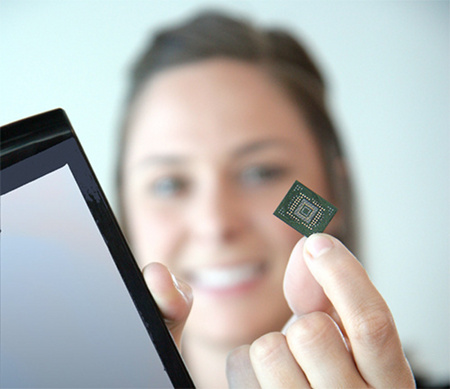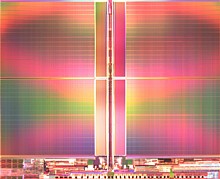Flash memory shrinks to fit embedded devices
Aug 18, 2010 — by LinuxDevices Staff — from the LinuxDevices Archive — 1 viewsSanDisk announced an SSD (solid state drive) it touts as the first of a new breed aimed at embedded devices. The integrated SSD (iSSD) packs from 4GB to 64GB of storage, yet it's smaller than a postage stamp and weighs less than a paper clip, the company says.
According to SanDisk, its iSSD is the first such device to support the industry-standard SATA interface, while also coming in a small package that can be soldered onto any motherboard. The device uses a BGA (ball grid array) form factor of just .78 x .62 x .09 inches (20mm x 16mm x 1.85mm), weighing as little as 0.02 ounces (0.83g), the company says.

SanDisk's iSSD
SanDisk adds that the iSSD (above) is "fast enough for use for advanced operating systems in next-generation mobile computing platforms," offering sequential read speeds of 160MB/sec. and sequential writes of 100MB/sec. The device will help lower power consumption and keep devices cool, the company says.
Doron Myersdorf, senior director of SSD marketing for SanDisk, stated, "The new category of embedded SSDs should enable OEMs to produce tablets and notebooks with an unprecedented combination of thin, lightweight form factors and fast performance. With our embedded flash storage leadership, SanDisk believes it is uniquely positioned to deliver the ultra compact SSD solutions needed by OEMs."
Jeff Janukowicz, research manager, solid state drives for IDC, was quoted as saying, "Yhe ultra-thin tablet and mobile computer markets are expected to experience tremendous growth over the coming years, and new advanced platforms will introduce new requirements for storage solutions. New embedded SSDs such as the SanDisk iSSD drive, which meet the stringent size requirements of small and light devices while offering greater performance, are designed to enable OEMs to deliver an enhanced user experience in their next-generation designs."
Intel and Micron shrink flash memory, too
Separately, Intel and Micron said they are now sampling three-bit-per-cell (3bpc) NAND flash memory. Also referred to as TLC (triple-level cell), the technology stores three bits of information per cell, rather than the traditional one-bit (SLC, or single-level cell) or two bits (MLC, or multi-level cell).
In January, the companies' joint venture, IM Flash Technologies (IMFT), announced an 8GB MLC NAND using their 25nm manufacturing process, with a resulting size of just 16.7 x 16.7mm. Now, it's said, the move to TLC technology will further shrink the size of an 8GB NAND to just 13.1 x 13.1mm.

Intel's 25nm, 8GB TLC NAND die
Tom Rampone, Intel vice president and general manager of the company's NAND Solutions Group, stated, "With January's introduction of the industry's smallest die size at 25nm, quickly followed by the move to 3-bit-per-cell on 25nm, we continue to gain momentum and offer customers a compelling set of leadership products. Intel plans to use the design and manufacturing leadership of IMFT to deliver higher-density, cost-competitive products to our customers based on the new 8GB TLC 25nm NAND device."
Availability
According to SanDisk, the iSSD is sampling now to OEMs, and "is being evaluated by top-tier manufacturers. It's said capacities will range from 4GB to 64GB, but pricing and a date for end-user availability were not specified. More information may be found on the company's website, here.
Intel, meanwhile, says its TLC NAND flash chips will be "in full production" by the end of this year. The chipmaker says it is already working to qualify the chips in higher-capacity storage devices that will be released by Lexar Media and Micron.
This article was originally published on LinuxDevices.com and has been donated to the open source community by QuinStreet Inc. Please visit LinuxToday.com for up-to-date news and articles about Linux and open source.